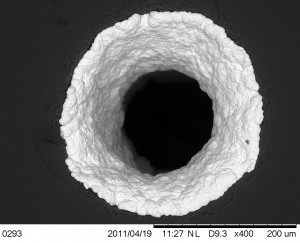MEMS Langmuir Probes for Atmospheric Reentry Plasma Diagnostics
- Category: MEMS & BioMEMS
- Tags: Akintunde Akinwande, Ella Field, Luis Velásquez-García
One of the most fundamental technical problems concerning spacecraft design is preparing the vehicle to survive the extreme conditions encountered during reentry into the Earth’s atmosphere [1] . When a hypersonic vehicle travels through the atmosphere, a high-density, low-temperature plasma sheath forms around it [2] . The reentry plasma sheath affects heat transfer to the spacecraft, aerodynamics, and perhaps most notably, communications. A communications blackout is a major threat, bringing about a complete loss of RF signal strength between the reentry vehicle and the ground. A thorough knowledge of reentry plasma sheath properties is needed to effectively develop systems capable of maintaining communications during reentry. However, the reentry plasma sheath occurs due to processes that are not well understood. Furthermore, the conditions of the plasma sheath rapidly change throughout reentry, which introduces additional complications. Analytical approaches alone are not sufficient to gain a complete understanding of the plasma sheath. Therefore, instrumentation must be developed to measure properties of the plasma sheath during reentry [3] .
We propose a novel approach to reentry plasma diagnostics, utilizing planar arrays of MEMS Langmuir probes to perform real-time measurements of the electron temperature and number density of the reentry plasma sheath. The MEMS Langmuir probes, shown in Figure 1, consist of an array metallic vias in a high temperature-resistant dielectric substrate, which can be blended onto the outer surface of a reentry vehicle (i.e., as a sensorial skin). Figure 2 shows one of the early prototypes we made as proof of concept of the device process flow. The MEMS Langmuir probes are made using electroplated gold and an ultrasonic drilled Pyrex substrate. The performance of the MEMS probes will be validated experimentally in laboratory plasmas similar to those encountered by spacecraft during reentry.
- Figure 1: Cross section schematic of the arrays of MEMS Langmuir Probes. The tapered vias facilitate metal filling-in.
- Figure 2: SEM of a MEMS Langmuir probe test structure as seen from the plasma. Gold was electroplated into vias that were machined into a Pyrex substrate. In the test structure, the vias were partially filled to characterize film conformality and processing parameters. Longer electroplating time will result in completely filled-in vias, hence forming arrays of MEMS Langmuir probes.
- L. C. Scalabrin and I. D. Boyd, “Numerical simulation of weakly ionized hypersonic flow for reentry configurations,” in 9th AIAA/ASME Joint Thermodynamics and Heat Transfer Conf., 2006 © AIAA. DOI: 2006-3773. [↩]
- K. M. Lemmer, A. D. Gallimore, and T. B. Smith, “Using a helicon source to simulate atmospheric re-entry plasma densities and temperatures in a laboratory setting,” IEEE Plasma Sources Sci. Technol., vol. 18, no. 2, May 2009. [↩]
- J. P. Rybak and R. J. Hill, “Progress in reentry communications,” IEEE Transactions on Aerospace and Electronic Systems, vol. aes-7, no. 5, pp. 879-894, Sept. 1971. [↩]

